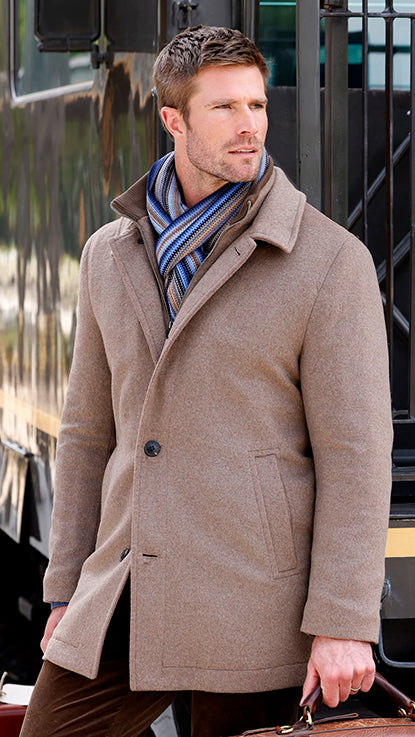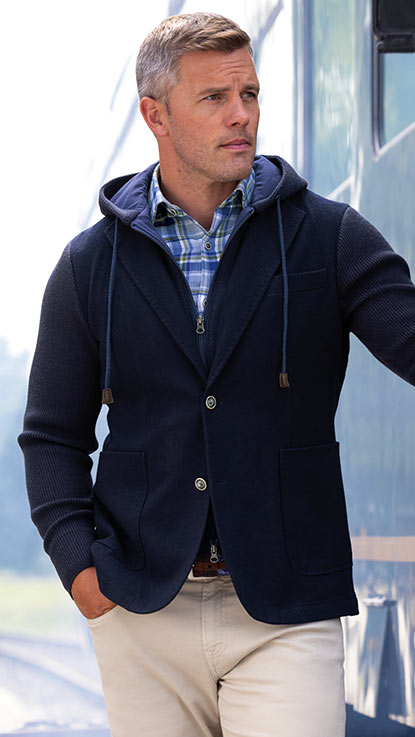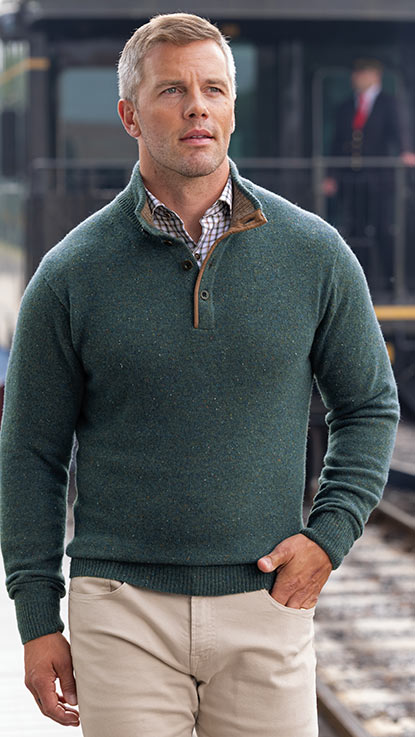
Pick one of the following color palettes to get Topper's thoughts on piecing together the right combinations:
How to Wear Green
Men's Fashion Guide: Colors
E.J. Topper's Colorful Thoughts about Green:
Green with envy or just green around the gills? This color presents us with one of the widest and most versatile set of choices of all. Getting it right with green can be supremely relaxing. So what does Topper think?
When Topper sees the color green, he’s reminded of the rolling hills of Scotland, the thick bamboo forests of Japan and shades in the crystal-clear waters of the Caribbean. Occasionally, we must admit, he may also be fondly recalling the olive that garnished his dry martini the previous night. Whatever the specific memory may be, with the sight of green he is immediately transported to a calmer place away from the bustling atmosphere of the city.
Natural beauty and rustic ambiance inspire Topper’s fashion choices, to the extent that he adds a touch of green to his outfits whenever possible, especially in the spring and fall, when nature – in his opinion – is at her own fashion best. According to Topper, “Green is one of the easiest colors to work with, but its various hues and compatibility with many other colors can sometimes make it more difficult to sort out a proper outfit.”
So, how can you successfully wear the right shade of green at the right time? Here’s how to add a touch of nature to your wardrobe – in any season. And success begins with a rather more precise idea of what we actually mean by “green”. By selecting more precise shades, and then understanding how they best interact with other colors, we are closer to the sartorial green light.
Wearing Green with Style

Topper's Tips #1 – How To Wear: Pine
Best worn with: Black, brown, gray, burgundy, navy blue
This brisk, rustic shade is reminiscent of lush forests in cool climes. As such, it’s most fitting when worn in fall and winter. “Men who are at the height of fashion pair this color with other dark hues like navy blue and burgundy,” says Topper. “Outerwear pieces like overcoats, cardigans and sweaters stand out in fall and winter, while forest green pants, paired with a cranberry or navy blue sweater will deliver a warm, sophisticated look.”
Topper also warns us to be a little wary when considering certain color pairings. “Wearing a dark green overcoat with brown pants puts men – especially tall ones – at risk of looking like an actual pine tree. Avoid brown pants, and instead wear a brown blazer with forest green pants.”

Topper's Tips #2 – How To Wear: Mint
Best worn with: Black, white, gold, silver, coral, blue
Mint may seem like a pretty simple color to work to the inexperienced eye. But just as the mint julep is not to be taken in excessive quantities, as Topper will be quick to confirm, so bright or pastel shades, including mint green, must be handled more cautiously. The simple fact is that they don’t work well with many other colors.
Topper says, “Just as mint is an essential component of a good mojito, spring fashion isn’t complete without mint staple pieces and accents. Mint pants are especially on-trend during spring, when pastels take center stage.”
“Avoid wearing other light colors with mint, or risk looking washed out. Instead, choose classic neutrals, dark blues and coral.”

Topper's Tips #3 – How To Wear: Emerald
Best worn with: Black, white, silver, gold, orange, yellow
Jewel tones like emerald complement us best during autumn, when nature is at its brightest and most colorful. Topper recommends that everyone have at least one emerald item in their closet, saying: “Emerald shouldn’t just be part of the jewelry we typically buy our wives and girlfriends for Christmas – it’s a shade that should be taken advantage of during fall because it complements all skin tones.”
“Emerald plaid shirts are another fall fashion staple, but make sure your outfit isn’t too rustic (unless you’re going for the lumberjack look).” For Topper, “woodman, spare that tree” translates to “well dressed man, spare those forest tones”. Or, put another way, give too much green the axe!

Topper's Tips #4 – How To Wear: Lime
Best worn with: Black, white, royal blue
It’s a fine line with lime in Topper’s view, whether it’s the quantity of the actual citrus in a sublimely served cocktail or the presence of the color itself in an effortlessly elegant ensemble. In practical terms, because lime is such a bold hue, it’s best worn in moderation. Stick to accessories and accent colors when incorporating it into your outfit.
Topper says in summary, certainly do not rule out this hue because of its boldness, but embrace it subtly. As ever, he puts it best: “We tend to avoid wearing difficult shades like lime, but pulling them off is easy when we wear them in moderation, sporting a bow tie for example or watch strap. Wearing lime also shows your adventurous side – not many men attempt such a bold color.”

Topper's Tips #5 – How To Wear: Accessories
“Don’t underestimate the power of accessories,” says Topper. “An emerald tie or bow tie stands out against a white dress shirt, and a lime watch adds a fizz of color to an otherwise toned-down outfit. A few well-placed accessories really put the finishing touch in place. But think of them as the fireworks – exciting and made of light – rather than the fire itself.”
Topper also believes men shouldn’t neglect finding the right hues of shoe. And where footwear is concerned, there is no rule that says we always have to tread the same style path. As Topper remarks: “When it comes to shoes there is a time to leave the beaten track. Go off road for a change with lime green accents for a more subtle pop of color, or even a pair of pine green dress shoes for a more rustic look. But, as ever, be wary of the shade and type of shoe. A boot that’s completely green worn on a foot that is truly man size risks looking as if you are being attacked by a giant pickle.”
Make Onlookers Green with Envy
According to Topper, even if one is used to wearing green now and then, it doesn’t hurt to explore new ways to wear a standard color. “When it comes to fashion, so many men just don’t like to step out of our comfort zones. But evolution is necessary to avoid sartorial stagnation. And it doesn’t always have to mean revolution.”















